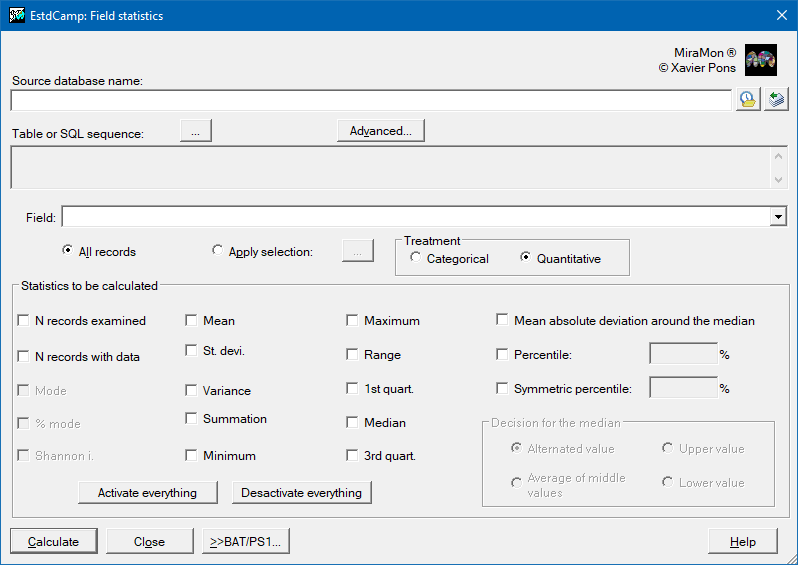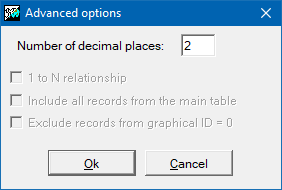-
 EstdCamp: Statistics of a table field or database query
EstdCamp: Statistics of a table field or database query
Direct access to online help: EstdCamp
Access the application from the menu: "Tools | Alphanumerical databases | Fields statistics"
Presentation and options
This application does statistical calculations on a table field. This can be any physical table or query such as the associated with a graphic layer from its corresponding REL file, and it can also be an individual DBF table or a table or SQL query via ODBC of a MDB, Oracle, etc, database.
The field can have quantitative treatment, giving rise to certain statistics: average, standard deviation, variance, sum and status; or categorical treatment, giving rise to mode, percentage of the mode and Shannon's index. Other statistics calculated in both cases, are the number of entire records with information (different from NoData), minimum (or first) and maximum (or last). On a numerical field a quantitative treatment is done automatically, whereas on the rest of the types a categorical treatment is done, although this behavior can be modified.
The result consists of a list with the descriptors and values of the chosen statistics that will be visualized directly in the results window of the graphic version of the application (WEstdCam) or in the command window of the console. The results can be copied from the results window of WEstdCam into the clipboard by means of the options of the mouse's secondary menu (right button). An output in INI format can also be optionally generated, with the name of the section corresponding to the field on which the statistics are calculated (for example, [AREA]), and a set of value keys that determine the calculated statistics and its value (for example, MITJANA=..., DESV_STD=...).
If it is a database of a graphic layer, the field in which the statistical calculations are done can be from the main table or from any associated table. In this second case, it is possible to demand a relation of non-multiple cardinality indicating the parameter /RELACIO_1_A_1, but a possible relation of multiple cardinality 1 to N will be established (unless in the metadata of another type of relation is indicated). In this case, it is also possible to decide if the records of the main table without linkage with the field of the associate table chosen for the calculations must be considered, indicating the parameter /TOTS_REG_PRAL.
If the graphic layer corresponds to a polygon file, the universal polygon (record or exceptional records of the zero graphic identifier) will not be considered. This polygon, which brings the exterior zones to all the polygons of the base, is meaningful inside the topological format, but it does not correspond to any thematic polygon. In some particular cases it is possible to add the record of the zero polygon by means of the parameter /AMB_ID_GRAFIC_0. These three parameters that modify the usual inventory of records and the later calculations can be activated from the advanced options of the graphic interface of the application (WEstdCam).
The calculations can be done on the whole base, table or selected query or on a subcommittee of records. This selection is defined from the linkage of a series of logical conditions on the fields of the base. The selection is defined with the same interface as the query by attribute of MiraMon giving rise to a syntax that it is possible to consult in the general syntax.
In quantile calculations, such as the median, it is possible to indicate, with the modifier /MEDIANA_EMPAT=, the type of tiebreaker to use for its calculation when the position of the quantile is between two values of the series. For more information, see general syntax.

Dialog box of the application

Syntax
Syntax:
- EstdCamp InputFile FieldConsulted Treatment [/N_REG_TOTALS] [/N_REG_DADES] [/MODA] [/PRCNT_MODA] [/I_SHAN] [/MITJANA] [/DESV_STD] [/VAR] [/SUMA] [/MIN] [/MAX] [/PRCNT_GRUP] [/PRCNT_GRUP_NODATA] [/RANG] [/MEDIANA] [/DESV_MEDIANA] [/1Q] [/3Q] [/PERCENTIL] [/PERC_SIM] [/MEDIANA_EMPAT] [/SQL] [/TAULA] [/RELACIO_1_A_1] [/TOTS_REG_PRAL] [/AMB_ID_GRAFIC_0] [/COND#_CAMP] [/COND#_OP] [/COND#_VALOR] [/COND#_NEXE] [/COND#_PRIOR] /INI
Parameters:
- InputFile
(Input file -
Input parameter): REL, DBF, DSN or MDB file from which the statistics of one of its fields will be defined.
- FieldConsulted
(Implied field -
Input parameter): Indicates the name of the field when there is no .rel from the table or when the .rel is from a version equal to or later than 4 (or for versions of .rel prior to 4, the index numbered from 0 must be indicated) on which statistical calculations are performed.
- Treatment
(Treatment -
Input parameter): Type of treatment that is done to the consulted field:
- C for a categorical treatment.
- N for a quantitative treatment.
- X means treatment by default (quantitative treatment for numerical fields and categorical for the rest).
- for the treatment documented in metadata (or by default as X if nothing is indicated).
Modifiers:
/N_REG_TOTALS
(Entire number of records)
This indicates that the entire number of records will be shown (it includes empty, white and NoData records). (Input parameter) /N_REG_DADES
(Number of records)
This indicates that the number of records with data will be shown (it does not include empty, white and NoData records). (Input parameter) /MODA
(Mode)
This indicates that the mode will be calculated for a categorical field. (Input parameter) /PRCNT_MODA
(Percentage of occurrence)
This indicates that the percentage of occurrence of the modal value will be calculated in a categorical treatment. (Input parameter) /I_SHAN
(Shannon index)
This indicates that the Shannon's index calculations will be done in a categorical treatment. (Input parameter) /MITJANA
(Medium)
This indicates that the medium will be calculated in a quantitative treatment. (Input parameter) /DESV_STD
(Standard deviation)
This indicates that the standard deviation will be calculated in a quantitative treatment. (Input parameter) /VAR
(Variance)
This indicates that you want to calculate the variance in a quantitative treatment. (Input parameter) /SUMA
(Sum)
This indicates that the sum of all the values will be calculated in a quantitative treatment. (Input parameter) /MIN
(Minimum value)
This indicates that the minimum value of a quantitative treatment, or the first value in alphabetical ascending order for the categorical treatment will be shown. (Input parameter) /MAX
(Maximum value)
This indicates that the maximum value of a quantitative treatment, or the last value in alphabetical ascending order for the categorical treatment will be shown. (Input parameter) /PRCNT_GRUP
(Number of values of an element)
This indicates that the number of values of an element of the projection (select distinct) in relation to the total values will be calculated. In this calculation NoData are not included. (Input parameter) /PRCNT_GRUP_NODATA
(Percentage of the value from the total values)
This indicates that the percentage of the value from the total values of the projection will be calculated. In this calculation NoData are included. (Input parameter) /RANG
(Range)
This indicates that you want to know the range in a quantitative treatment. (Input parameter) /MEDIANA
(Median)
This indicates that you want to know the median in a quantitative treatment. (Input parameter) /DESV_MEDIANA
(Mean absolute deviation around the median)
This indicates that the mean absolute deviation around the median in a quantitative treatment has to be reported. (Input parameter) /1Q
(First quartile)
This indicates that you want to know the first quartile in a quantitative treatment. (Input parameter) /3Q
(Third quartile)
This indicates that you want to know the third quartile in a quantitative treatment. (Input parameter) /PERCENTIL=
(Percentile)
This indicates that you want to know the indicated percentile in a quantitative treatment. The percentile must be a value between 0 and 100. (Input parameter) /PERC_SIM=
(Symmetric percentile)
This indicates that you want to know the indicated symmetric percentile in a quantitative treatment. The percentile must be a value between 0 and 100. (Input parameter) /MEDIANA_EMPAT=
(Decision for quantiles)
If the calculation of a quantile (such as the median, a quartile or a percentile) has been requested, it indicates the tiebreaking criterion to be used for its calculation. To learn more about the values of this parameter, please consult general syntax document. (Input parameter) /SQL=
(SQL)
When the input file is an MDB or DSN (via ODBC), this indicates the sentence in SQL language from which the different statistics will be calculated. (Input parameter) /TAULA=
(Table)
When the input file is an MDB or DSN (via ODBC), this indicates the table of the corresponding data base to which the field, on which the statistical calculations will be done, belongs. (Input parameter) /RELACIO_1_A_1
(Non-multiple relation)
This forces a non-multiple relation between the main table and the associated table. In its absence this limitation disappears and the multiple relation 1 to N is accepted. (Input parameter) /TOTS_REG_PRAL
(All records)
In the relations of the main table with the associated table, this indicates that the records of the main table that have no correspondence in the associated table or tables must also be included. In its absence there will only be those records that have correspondence across the established relations. (Input parameter) /AMB_ID_GRAFIC_0
(Graphic identifier)
In the case of a base of a polygon vector, this indicates the exceptional case of considering the attributes of the universal polygon or zero graphic identifier. Its absence implies excluding the records of the zero polygon in the statistical calculations. (Input parameter) /COND#_CAMP=
(Field of condition #)
Field name of # condition of selection. It may be made up to 100 simple queries and 100 field names (COND#_CAMP) starting at index 1. (Input parameter) /COND#_OP=
(Operator of condition #)
Operator to use in the # condition of selection. It may be made up to 100 simple queries and 100 operations (COND#_OP) starting at index 1. (Input parameter) /COND#_VALOR=
(Value of condition #)
Value to use in the # condition of selection. It may be made up to 100 simple queries and 100 values (COND#_VALOR) starting at index 1. (Input parameter) /COND#_NEXE=
(Nexus linking of condition #)
Nexus to use to link the successive selections. In this case to link condition # and condition #+1. It may be made up to 100 simple queries and 99 nexus (COND#_NEXE) starting at index 1. (Input parameter) /COND#_PRIOR=
(Priority of nexus linking of condition #)
Priority of nexus to use to linking for the successive selections. In this case to linking between condition # and condition #+1. It may be made up to 100 simple queries and 99 priorities (COND#_PRIOR) starting at index 1. This is an optional parameter. If it is not indicated the priority is just the order. (Input parameter) /INI=
(Temporary output text file)
Temporary text file in which all the descriptors and values of the selected statistics are written to be displayed directly in the results window of the graphical version of the application (wEstdCam) or in the command line window. The results obtained can be copied to the clipboard, from the results window itself, from the different menu options of the right mouse button. (Output parameter)


